WE RIDE BLAKE BAGGETT’S AMA NATIONAL CHAMPIONSHIP KAWASAKI KX250F
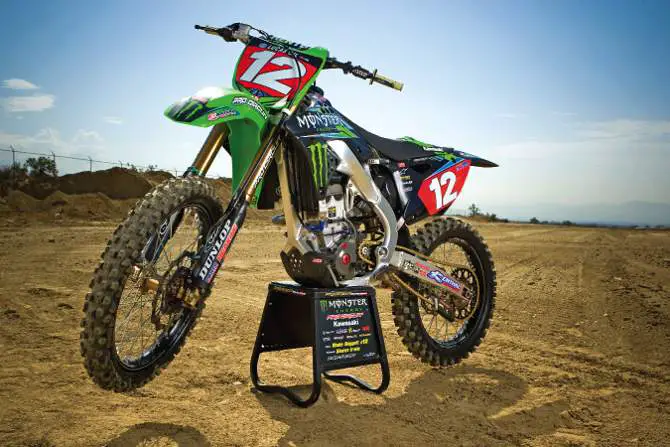
There were times in the 2011 AMA Motocross National Championship series when fans had to scratch their heads and wonder if Pro Circuit team manager Mitch Payton possessed some kind of motocross clairvoyance. His riders swept every step of the podium an amazing number of times?despite fierce competition. Just when we started to consider wearing tinfoil hats around Mitch so he couldn’t read our thoughts, his luck changed. For the 2012 season, his 250 championship effort would rest squarely on the shoulders of one rider: Blake Baggett. Dean Wilson and Darryn Durham were hurt. Tyla Rattray and Broc Tickle moved up to 450s. And, fill-in rider Ivan Tedesco put in spirited rides, considering his minimal preparation, until a second-moto crash at Budds Creek put an end to his season. The powerful Pro Circuit squad couldn’t sweep any podiums in 2012?because it only had one healthy rider.
With less-than-stellar performances in 250 Supercross, Blake Baggett didn’t appear to be at the top of his game coming into the 2012 outdoor season. Blake quickly squashed any Supercross-induced doubts, however, by racking up a series of come-from-behind wins. Throughout the season, Blake rode like a freight train?slow at the start, but building up unstoppable momentum. Blake won the 2012 AMA 250 National Championship, which is when MXA came calling. Since MXA had already tested Broc Tickle’s Pro Circuit KX450F, Mitch knew exactly which bike we wanted before he even picked up the phone.

Taking an in-depth look at the trick, unobtainable works parts on a Pro’s bike is always fun for motocross enthusiasts, but it’s even more fun when some of those parts are actually preproduction prototypes that will soon become available for purchase. Most factory riders help test parts for production, but a much greater number of Pro Circuit’s race-shop parts become available to customers than made-in-Japan factory works parts do?and much faster. After all, the OEMs’ job is to make rider-friendly, affordable production bikes to suit a wide range of people; Pro Circuit’s job is to make mods for hardcore racers.
You would think that Pro Circuit tailors each race engine to suit the power-delivery tastes of each rider on the team. Not so! Mitch Payton spends endless hours developing his race engines, and the team riders don’t get to choose from column A or column B like in a Chinese restaurant.

Blake Baggett’s KX250F didn’t have much bottom-end power, but the top end more than made up for it. It could pull through deep sand like a tractor.
Every rider gets the same engine. Pro Circuit race engines are designed to run for exactly two hours, which covers the practice sessions and both motos at an AMA National. At the end of two hours, the engines are rebuilt from top to bottom, whether they need it or not.
Although Pro Circuit sells almost every important part of their race engine to the public, there is a lot of special care evident in Blake Baggett’s race bike that the average race bike never gets. Need a list?
(1) Tranny. To handle the extra horsepower of the hopped-up engines and the extra abuse of professional riders, Pro Circuit contracts an outside company to make custom transmissions with the gear ratios that they specify.
(2) Clutch. The clutch is a full Hinson package, including basket, inner hub, pressure plate, fiber-driven plates and steel drive plates. Pro Circuit adds its firmer aftermarket clutch springs.
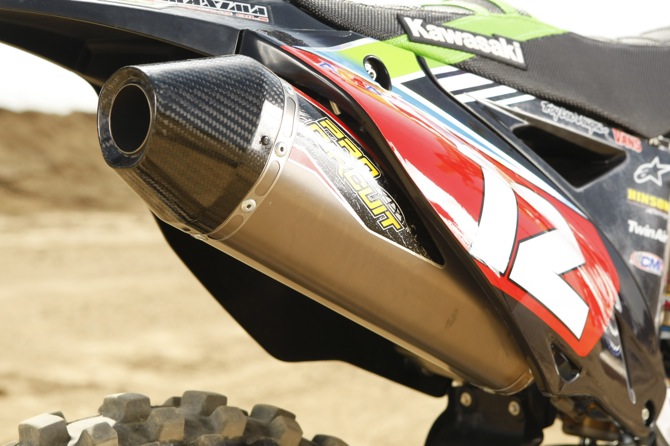
Baggett’s titanium exhaust looks similar to the off-the-shelf version, but it has been optimized for this race engine.
(3) Exhaust. Baggett’s exhaust system is based on Pro Circuit’s Ti-5 system, but with some dimension changes to work with Pro Circuit’s race engine. It also has an extra “skin” of titanium welded to the head pipe to prevent rock and crash damage and help ensure moto finishes.
(4) Cooling system. The high-output engine requires better cooling, and Pro Circuit addresses this issue with several modifications. First, they have an oil cooler custom-made in Italy that attaches to the back of the right radiator. Special fittings in the cases circulate the engine oil through the cooler. Second, Pro Circuit runs 2010 KX250F radiators because they are larger. The radiators are pressure tested, and the tanks are rewelded for safety. Third, Pro Circuit has its own in-house water pump that more efficiently circulates the water and cuts down on cavitation. Fourth, the stock 1.1 radiator cap is replaced with a higher-pressure 1.8 radiator cap, and a titanium overflow bottle recycles any coolant that does boil over. In Supercross. since it is less demanding on the engine, Pro Circuit runs radiators with smaller cores, and they eliminate the oil coolers.
(5) Gas tank. Another outdoor-only part on Blake Baggett’s bike is the custom-made, Italian, carbon fiber gas tank, which is illegal in Supercross. It has a larger capacity than the stock tank to ensure that Baggett doesn’t run out of gas. Other carbon fiber pieces include Pro Circuit’s extra-long carbon fiber chain guide and a LightSpeed carbon fiber skid plate, carbon rear brake guard and a carbon fiber throttle-position sensor guard.

Blake’s race motor has a custom-built transmission. Pro Circuit chooses each internal gear ratio to suit their needs.
(6) Forks. Baggett’s KX250F is equipped with Showa SFF A-kit forks. The fork valving has a larger piston and shims to allows for more precise valving. The fork legs are titanium nitrate-coated. Pro Circuit has an exclusive fork lug that they redesigned for the 2012 season for the latest Showa Separate Function Forks. These lugs are wider and more rigid than standard axle lugs to give the riders better front-end feel when charging through ruts or taking big impacts.
(7) Spring rates. Generally, fast Pros are known for having very stiff suspension, but Baggett’s lean-and-mean stature offsets his lightning speed. At 127 pounds, wearing size-29 pants, Blake would fight in the featherweight class if he were a boxer (a featherweight boxer is 126 pounds). A KX250F comes stock with a 0.91 kg/mm fork spring and a 4.2 kg/mm shock spring, while Baggett uses a 8.4 Nm spring on the front and the stock 4.2 kg/mm rate in a titanium spring on the rear.
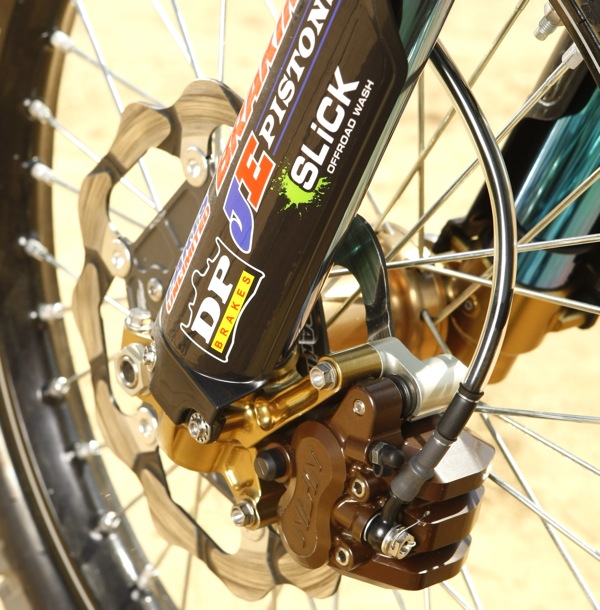
(8) Brakes. Baggett’s rear-brake system includes a Braking 240mm standard-size rotor, stock caliper, stock master cylinder, made-in-house aluminum clevis and a titanium pin. The clevis and pin tighten up tolerances to ensure that Blake’s pedal-to-caliper actuation is instantaneous. The front-brake system includes an oversize 270mm Braking Batfly rotor, works Nissan magnesium caliper and stock master cylinder.
(9) Wheels. At first glance, Pro Circuit’s hubs appear to be magnesium, but they are actually aluminum KHI (factory Kawasaki Japan) parts with an anodized coating that resembles magnesium. The rims are Excel A60s, and the sprockets come from Renthal. The A60s were equipped with a 110/90-19 Dunlop 762 rear (this tire isn’t available to the public). Blake runs this 762 tire at every track?unless the conditions are extreme. On the front, Blake runs a front tire that says MX51 on it, but we bet that the rubber compound is finagled for different track conditions.

(10) Controls. Blake’s smaller stature is evident in all of his personal cockpit settings. The bike has Renthal TwinWall 997 bars rotated back with the bar mounts in the rearmost position. There is half a Renthal crossbar pad glued under the seat cover to serve as a seat hump. It is located farther forward than most seat humps. The subframe is cut down 5mm to lower the rear end, and the footpegs are raised 5mm.
(11) Levers. Every Pro Circuit rider but Blake runs ARC composite folding brake and clutch levers. Blake prefers the hard feel of aluminum levers. Blake also chooses Renthal Kevlar grips with grip donuts on both sides and clear grip tape on the frame, airbox and side plates. Pro Circuit’s race-team shift levers are now available to the public. The special thing about the shifters is that when the tip pivots, it is still protected from mud intrusion, so it will always operate smoothly.

(12) Footpegs. Blake’s Pro Circuit footpegs began life as off-the-shelf parts, but were customized for Blake. First, they were cut and rewelded 5mm taller, then the teeth were ground as sharp as a piranha’s. Finally, Pro Circuit made a titanium cover that fits on the bottom of the footpeg pivot and prevents mud from getting in and jamming things up. These Ti footpeg covers are truly an upper-echelon works part, because they are expensive to make and the riders go through them quickly.

(13) Titanium. Also upper echelon are the titanium and aluminum fasteners all over the bike. The axles, swingarm pivot and high-torque fasteners are titanium, while many of the shroud and low-torque fasteners have drilled-out aluminum flanges, which are even lighter than titanium.
(14) Triple clamps. Pro Circuit redesigned their triple clamps a year ago, and the new versions are now available to the public. Blake’s clamps are 24mm offset versus the stock 22.5mm offset. Pro Circuit’s race bikes utilize their new magnetic-hook-design holeshot device (although for our test they installed a fork guard with the old two-button model).
(15) Miscellaneous. Baggett’s bike also uses Maxima lubricants, Pro Circuit radiator hoses, Pro Circuit axle blocks, N-Style graphics and seat cover, and a carbon-fiber transponder holder.
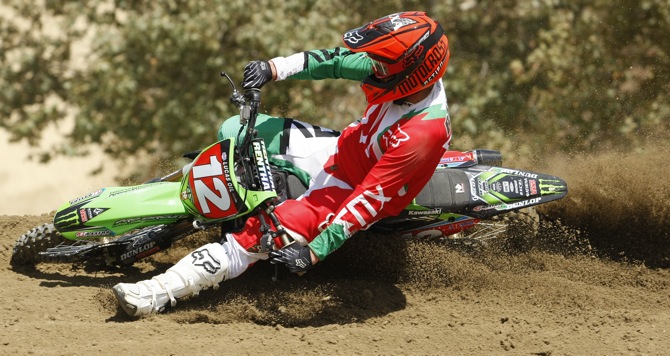
You have to be impressed with Pro Circuit’s commitment to modify, redesign or fabricate every part on their race bikes, but the proof isn’t in the pudding; it’s on the track. Being taller and heavier than Blake Baggett, we felt cramped sitting on his bike. This concludes our complaining portion of the test, because once we cracked the throttle, everything started coming up aces.
The engine was eye-wateringly fast. It didn’t have much bottom, but it hit hard in the midrange and delivered a truckload of over-rev. Pros carry so much corner speed that the bottom end isn’t important for a 250F. They breeze right past it.
Even though the bike would gladly rev to the moon, the fastest way to ride it was to keep it in the sweet spot, which was on or just after the midrange. Following this formula, Baggett’s bike ate up racetrack yardage with gusto. The power was especially noticeable pulling up steep hills and clawing its way out of soft berms when we buried the wheels.
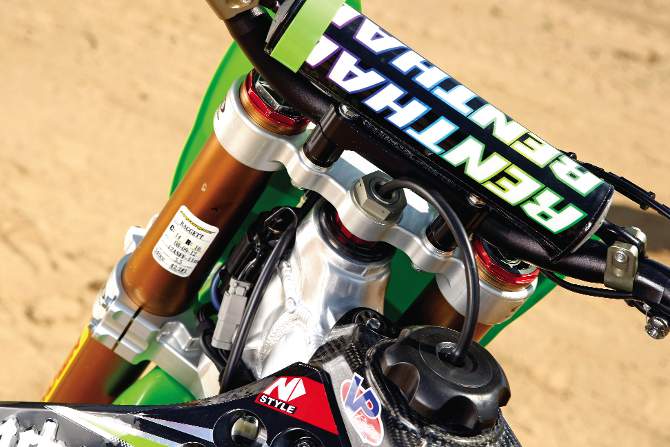
Pro Circuit’s triple clamps were redesigned a year ago for optimal flex properties, tested on the track and on sale now.
Blake’s outdoor suspension settings are surprisingly plush for a fast guy. This is the type of suspension that an intermediate rider of similar weight would love and that anyone can appreciate. The forks and shock both move fluidly through their stroke with no hiccups or harsh spots whatsoever. The most impressive trait of the suspension was how it handled hard braking into turns with big braking bumps. The bike stayed so flat and stable, we almost considered balancing a glass of wine on the rear fender like in the TempurPedic commercials.
The entire package was confidence-inspiring. The front brakes were super powerful yet surprisingly mushy. This would have shocked us a few years ago, but as oversize brakes have gotten more powerful, the riders have started to set them up with a little more give at the lever. (Ryan Dungey’s brake setup was very close to Blake Baggett’s.) There was tons of stopping power available, but the lever had to be pulled a long way to get there.
If Blake Baggett’s bike felt like a rocket ship with a 180-pound MXA test rider on board, imagine how it feels to Blake, who is 53 pounds lighter. The Pro Circuit machine was definitely worthy of a champion, but better yet, it was worthy of an average rider too. We could have ridden it all day, but Pro Circuit sent a mechanic along with the bike. His job? To hold a stopwatch to make sure that we didn’t exceed the two-hour time limit on the engine.
For more info go to www.procircuit.com.

Pro Circuit’s titanium overflow bottle is a work of art. It siphons any boiled-over coolant back into the radiators.




Comments are closed.